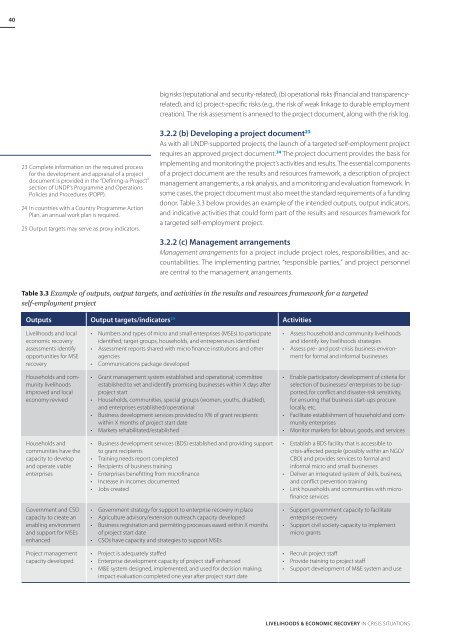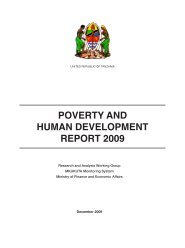Download PDF (4.08 MB) - ReliefWeb
Download PDF (4.08 MB) - ReliefWeb
Download PDF (4.08 MB) - ReliefWeb
Create successful ePaper yourself
Turn your PDF publications into a flip-book with our unique Google optimized e-Paper software.
40<br />
big risks (reputational and security-related), (b) operational risks (financial and transparencyrelated),<br />
and (c) project-specific risks (e.g., the risk of weak linkage to durable employment<br />
creation). The risk assessment is annexed to the project document, along with the risk log.<br />
23 Complete information on the required process<br />
for the development and appraisal of a project<br />
document is provided in the “Defining-a-Project”<br />
section of UNDP’s Programme and Operations<br />
Policies and Procedures (POPP).<br />
24 In countries with a Country Programme Action<br />
Plan, an annual work plan is required.<br />
25 Output targets may serve as proxy indicators.<br />
3.2.2 (b) Developing a project document 23<br />
As with all UNDP-supported projects, the launch of a targeted self-employment project<br />
requires an approved project document. 24 The project document provides the basis for<br />
implementing and monitoring the project’s activities and results. The essential components<br />
of a project document are the results and resources framework, a description of project<br />
management arrangements, a risk analysis, and a monitoring and evaluation framework. In<br />
some cases, the project document must also meet the standard requirements of a funding<br />
donor. Table 3.3 below provides an example of the intended outputs, output indicators,<br />
and indicative activities that could form part of the results and resources framework for<br />
a targeted self-employment project.<br />
3.2.2 (c) Management arrangements<br />
Management arrangements for a project include project roles, responsibilities, and accountabilities.<br />
The implementing partner, “responsible parties,” and project personnel<br />
are central to the management arrangements.<br />
Table 3.3 Example of outputs, output targets, and activities in the results and resources framework for a targeted<br />
self-employment project<br />
Outputs Output targets/indicators 25 Activities<br />
Livelihoods and local<br />
economic recovery<br />
assessments identify<br />
opportunities for MSE<br />
recovery<br />
Households and community<br />
livelihoods<br />
improved and local<br />
economy revived<br />
Households and<br />
communities have the<br />
capacity to develop<br />
and operate viable<br />
enterprises<br />
Government and CSO<br />
capacity to create an<br />
enabling environment<br />
and support for MSEs<br />
enhanced<br />
Project management<br />
capacity developed<br />
• Numbers and types of micro and small enterprises (MSEs) to participate<br />
identified; target groups, households, and entrepreneurs identified<br />
• Assessment reports shared with micro finance institutions and other<br />
agencies<br />
• Communications package developed<br />
• Grant management system established and operational; committee<br />
established to vet and identify promising businesses within X days after<br />
project start<br />
• Households, communities, special groups (women, youths, disabled),<br />
and enterprises established/operational<br />
• Business development services provided to X% of grant recipients<br />
within X months of project start date<br />
• Markets rehabilitated/established<br />
• Business development services (BDS) established and providing support<br />
to grant recipients<br />
• Training needs report completed<br />
• Recipients of business training<br />
• Enterprises benefitting from microfinance<br />
• Increase in incomes documented<br />
• Jobs created<br />
• Government strategy for support to enterprise recovery in place<br />
• Agriculture advisory/extension outreach capacity developed<br />
• Business registration and permitting processes eased within X months<br />
of project start date<br />
• CSOs have capacity and strategies to support MSEs<br />
• Project is adequately staffed<br />
• Enterprise development capacity of project staff enhanced<br />
• M&E system designed, implemented, and used for decision making;<br />
impact evaluation completed one year after project start date<br />
• Assess household and community livelihoods<br />
and identify key livelihoods strategies<br />
• Assess pre- and post-crisis business environment<br />
for formal and informal businesses<br />
• Enable participatory development of criteria for<br />
selection of businesses/ enterprises to be supported,<br />
for conflict and disaster-risk sensitivity,<br />
for ensuring that business start-ups procure<br />
locally, etc.<br />
• Facilitate establishment of household and community<br />
enterprises<br />
• Monitor markets for labour, goods, and services<br />
• Establish a BDS facility that is accessible to<br />
crisis-affected people (possibly within an NGO/<br />
CBO) and provides services to formal and<br />
informal micro and small businesses<br />
• Deliver an integrated system of skills, business,<br />
and conflict prevention training<br />
• Link households and communities with microfinance<br />
services<br />
• Support government capacity to facilitate<br />
enterprise recovery<br />
• Support civil society capacity to implement<br />
micro grants<br />
• Recruit project staff<br />
• Provide training to project staff<br />
• Support development of M&E system and use<br />
Livelihoods & Economic Recovery in Crisis Situations





